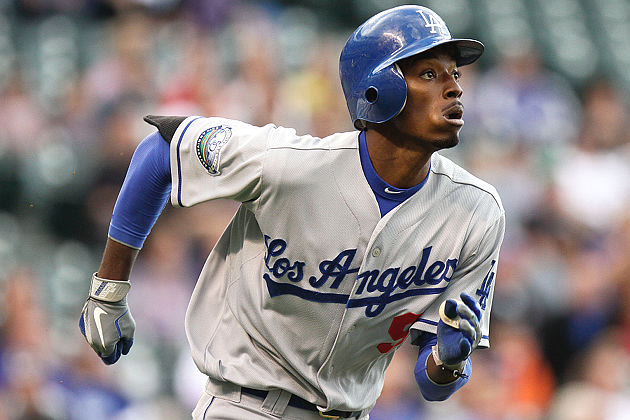It's the time of the baseball year where we look at team's prospects.
Prospect lists are coming out.
We wonder who our teams could trade our prospects for or what prospects they could get in return.
We wonder if our prospects will make the metamorphosis from prospect to big leaguer.
Well, I'm going to take a quick look at how former Dodger prospects have fared with other teams.
These 10 pitchers have been recently traded by the Dodgers and appeared in the majors last season: Nate Eovaldi, Josh Lindblom, James McDonald, Steven Ames, Steve Johnson, Rubby de la Rosa, Josh Wall, Allen Webster, Luis Garcia, and Brian Morris.
They combined to go 17-31 in 372 innings last season with a 5.03 ERA, 4.68 FIP, 4.57 xFIP, 4.60 SIERA and -.6 WAR.
*source
Overall, it doesn't look like the Dodgers gave up too much value.
The best performer was Nate Eovaldi who was traded for Hanley Ramirez. Eovaldi was 4-6 with a 3.39 ERA in 106 innings for the Marlins last year. He had ad 3.59 FIP, 4.15 xFIP and was worth 1.5 WAR. That was a solid season, but certainly nothing like what Hanley Ramirez (5.1 WAR) did.
Other than that, there wasn't much success. Josh Lindblom (traded with Ethan Martin for Shane Victorino) pitched 31 innings for the rangers with a 5.46 ERA but 4.42 FIP and 4.50 xFIP worth .4 WAR.
Two highly thought of pitching prospects were traded to Red Sox in themother of all trades Gonzalez, Crawford, Beckett, Punto trade. Allen Webster and Ruby de la Rosa went 1 - 4 with a 7.78 ERA (6.26 FIP, 5.19 xFIP, 4.84 SIERA) worth -.4 WAR in 42 innings.
The hitters the Dodgers traded fared a bit better. Carlos Santana, Andrew Lambo, Tony Abreu, Blake DeWitt and Andy LaRoche combined to hit .265/.359/.448 for a .352 wOBA which was 27% better than the league average hitter in 830 PA's. Their overall WAR was 3.9.
*source
Most of that was Carlos Santana who went to the Indians in 2008 for Casey Blake's salary. Santana hit .268/.377/.455 in 642 PA's. That's good for a .364 wOBA (35% better than the league average hitter) and 3.6 WAR.
The Dodgers have traded more than a few players over the last few seasons, only two of them (Eovaldi and Santana) provided substantial value in 2013.
Prospect lists are coming out.
We wonder who our teams could trade our prospects for or what prospects they could get in return.
We wonder if our prospects will make the metamorphosis from prospect to big leaguer.
Well, I'm going to take a quick look at how former Dodger prospects have fared with other teams.
These 10 pitchers have been recently traded by the Dodgers and appeared in the majors last season: Nate Eovaldi, Josh Lindblom, James McDonald, Steven Ames, Steve Johnson, Rubby de la Rosa, Josh Wall, Allen Webster, Luis Garcia, and Brian Morris.
They combined to go 17-31 in 372 innings last season with a 5.03 ERA, 4.68 FIP, 4.57 xFIP, 4.60 SIERA and -.6 WAR.
*source
Overall, it doesn't look like the Dodgers gave up too much value.
The best performer was Nate Eovaldi who was traded for Hanley Ramirez. Eovaldi was 4-6 with a 3.39 ERA in 106 innings for the Marlins last year. He had ad 3.59 FIP, 4.15 xFIP and was worth 1.5 WAR. That was a solid season, but certainly nothing like what Hanley Ramirez (5.1 WAR) did.
Other than that, there wasn't much success. Josh Lindblom (traded with Ethan Martin for Shane Victorino) pitched 31 innings for the rangers with a 5.46 ERA but 4.42 FIP and 4.50 xFIP worth .4 WAR.
Two highly thought of pitching prospects were traded to Red Sox in the
The hitters the Dodgers traded fared a bit better. Carlos Santana, Andrew Lambo, Tony Abreu, Blake DeWitt and Andy LaRoche combined to hit .265/.359/.448 for a .352 wOBA which was 27% better than the league average hitter in 830 PA's. Their overall WAR was 3.9.
*source
Most of that was Carlos Santana who went to the Indians in 2008 for Casey Blake's salary. Santana hit .268/.377/.455 in 642 PA's. That's good for a .364 wOBA (35% better than the league average hitter) and 3.6 WAR.
The Dodgers have traded more than a few players over the last few seasons, only two of them (Eovaldi and Santana) provided substantial value in 2013.



